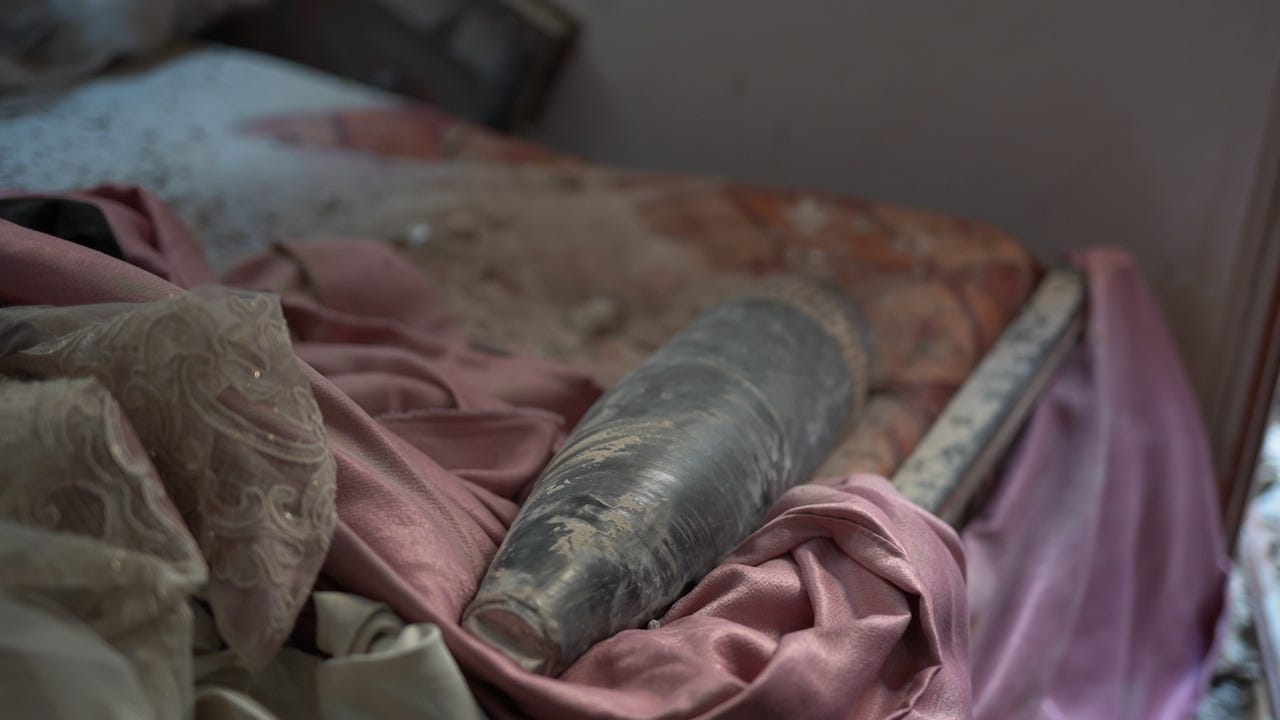Explosive Remnants in Gaza Cause Dozens of Casualties
Up to 10% of munitions fired by Israel into Gaza have failed to detonate, leaving behind deadly hazards for years to come

On January 19, the day the “ceasefire” in Gaza went into effect, 29-year-old Yousef Kassab couldn’t wait to return to his neighborhood of Tel al-Sultan in central Rafah to check on his home. He left ahead of his father along with his nephew and neighbor. But when he arrived, he couldn’t find his house—the Israeli military had destroyed the building and bulldozed the ground where it once stood.
His neighbor’s home nearby was battered, yet somehow still standing, so the three of them went inside to take a break and inspect the damage, Kassab’s father told Drop Site News. “As they were about to leave, Yousef was near the kitchen window and saw a strange object that blew up in his face,” Kassab’s 53-year-old father said. “This is what his neighbor and nephew told me after they were severely wounded by the explosion.”
Mohammed arrived just minutes after the explosion to find his son dead on the ground. “I found him with half a head and several gashes in his body. The two others had serious shrapnel wounds. There was blood splattered all over the floor,” Mohammed said. “I took Yousef and buried him in a graveyard in Khan Younis. I couldn’t take the loss since I lost many of my relatives and he was my only son, he was my backbone, he was everything in my life.”
Yousef, a father of three, was killed by a munition fired into Gaza that had failed to detonate, until he came upon it in his neighbor’s house. Dr. Zaher al-Wahaidi, the director of the Information Center at Gaza’s Ministry of Health, told Drop Site that Yousef was one of at least two people killed by unexploded ordnances in Gaza since the ceasefire began, with at least 40 others wounded.
The Israeli military has fired tens of thousands of munitions into Gaza since the war began on October 7, 2023—most of them U.S.-made—with as many as 30,000 bombs dropped in the first seven weeks alone. The United Nations Mine Action Service (UMAS), which has been operating in Gaza since 2009 and remained there throughout the past 15 months, has warned that between 5 to 10 percent of weapons fired into Gaza have failed to detonate, leaving behind deadly hazards for years to come. Since October 2023, at least 92 people have been killed or injured by explosive ordnance, UMAS chief Luke Irving told reporters in a live streamed press briefing from Gaza on January 29. He added that informal reports suggested there have been 24 victims of unexploded ordnance since the ceasefire began.
“Since the ceasefire came into effect, people have started returning to their homes and humanitarian personnel can reach areas which have previously been inaccessible,” Irving said. “We have already received informal reports of civilians coming across explosive ordnance in their homes, and humanitarian convoys are finding items more and more as we reach new areas which we previously could not get to. These include large aircraft bombs, mortars, anti-tank weapons, rockets and rifle grenades.”
Most of the victims of unexploded ordnances since January 19 have been in southern Gaza, according to al-Wahadi, who pointed out that the destruction in the north was more severe, with most of the buildings completely destroyed and reduced to piles of rubble. While the damage was catastrophic in the south as well, there are more buildings standing for people to seek shelter in or to try and dig out the bodies of their relatives and friends where they can come into contact with an exposed munition.
“Around 10 days ago, 12 people were maimed by a suspicious object in Khan Younis,” al-Waidi said. “These strange objects or not that visible, or sometimes that can look like normal things. That’s why deaths and injuries occur despite the efforts from UNMAS and local health organizations to prevent such incidents.”
Despite the enormous scale of the problem, with thousands of unexploded munitions scattered across Gaza, there are currently only five UMAS personnel operating in the enclave. Israel has also blocked the entry of heavy machinery and bulldozers into Gaza for debris removal in violation of the ceasefire agreement, making it harder for the long task of clearing the rubble to even begin.
“I’ll give some context,” Irving said. “If you imagine Europe post World War II—they still find items today, so these things never quite go away.”
Rola Sababah, a 25-year-old displaced resident of the Saudi neighborhood in western Rafah, returned to her home after the ceasefire to find only debris. She said she saw unexploded munitions around her home and in the streets.
“Explosives and mines were everywhere,” Sababah told Drop Site. “It was truly horrifying to witness this scene because our lives were in peril every moment. We were walking very carefully over Israeli tank tracks to avoid harm. Mines were apparent in certain areas and were marked with yellow tape and signs. The agricultural land was also full of mines, so it was impossible to walk there. Each step was frightening as it could have been our last.”
“These unexploded bombs are also under the rubble of people’s homes,” she added. “We saw many casualties the last few days as people were clearing up the rubble and looking for their loved ones.”
Since the ceasefire began, Israel has violated the agreement to such a degree—killing civilians, blocking the entry of essential supplies, including heavy machinery, fuel and humanitarian aid—that it prompted Hamas to announce on Monday it was indefinitely postponing the next planned release of three Israeli captives, scheduled for Saturday. Israel responded by threatening a full resumption of the war. Critical negotiations are currently underway to try and salvage the ceasefire.
“We don’t have the basic vehicles, like bulldozers, to remove the debris,” Raed Al-Dahshan, the director of Civil Defense in Gaza, told Drop Site. The Civil Defense has issued repeated public warnings that large numbers of unexploded ordnance remain scattered in the streets inside destroyed or damaged buildings. “We call on all organizations to supply us with tools and heavy vehicles to help retrieve bodies and avoid any casualties because of Israel’s remaining explosives. As long as we don’t have the equipment, we are still years ahead to clear up the rubble and recover the thousands of bodies still missing.”
Among the most common victims of unexploded ordnance are children, as they are often unaware of the danger.
“Children, who play outside or have fun in the streets, always pick up these unknown objects and have amputations and life-changing injuries as a result,” said Dr. Alliya Qazi, an American trauma surgeon who has volunteered in Gaza twice on medical missions. “Clearing up mines and unexploded ordnances normally takes years. I am very concerned that this will be a problem and will cause many injuries because we have seen similar scenarios in the past. ”
“There has to be a mass education campaign to warn people against this, to not pick up items from the roads” Qazi told Drop Site. “Even in places that have coordinated campaigns, these objects can be hidden and unknown, amounting to many more casualties.”







Shameful. Many yet to be maimed and killed. The International Community must speak up to allow in machinery to help clear these unexploded weapons.
I still struggle to understand how we allowed and even assisted this genocide …which may not be over by a long shot! But I did wonder if Trump was serious or as usual, just talking out his ass! He did seem like he was on the verge of dry humping a map of Gaza